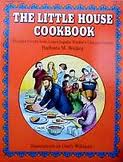 An excerpt from The Little House Cookbook: Frontier Foods from Laura Ingalls Wilder’s Classic Stories:
An excerpt from The Little House Cookbook: Frontier Foods from Laura Ingalls Wilder’s Classic Stories:
Everything must be saved, nothing wasted of all the summer’s bounty. Even the apple cores were saved for making vinegar…
– Farmer Boy
A quantity of good vinegar was important to a family that preserved its own meat and vegetables… Since store products might contain dangerous acids, careful housewives made their own vinegar, taking pride in the special flavors they acheived. They began at preserving time with a clean barrel open at the top for air and receiving and fitted with a bung at the bottom for decanting. Into the barrel went rain water, some of last year’s vinegar, and the peel and cores from apple canning and drying. Sweetening might be added in the form of preserve-kettle skimmings, molasses-barrel rinsings, honey, or brown sugar. In time this mixture fermented, resembling hard cider or wine; in more time-several months-the ferment turned acid and became vinegar. In spring part of the the batch might be moved to an outdoor barrel and mixed with rainwater and spices to become next seasons pickling vinegar…
Start your vinegar making as soon as the season’s new apple crop is available so you can make several tries if necessary.
For 1/2 gallon of cider vinegar you will need:
- 1/2 gallon of spring, rain, or well water
- 2 c. honey
- 12 or more apple peels and cores
- 1/2 package of dry yeast (1 1/2 tsps)
- 1/2 c. cider vinegar, commercial (for comparison only)
1. Small barrel or plastic gallon jug (used plastic milk jug); cord or lid; sipping straws. *If a plastic milk jug is to be used, wash well and scald with hot water to kill any bacteria.
2. Find a place in the warm kitchen where it can rest on a side, with the narrow opening serving as a bunghole.
3. Cut an opening on the top surface to receive a wide cork or plastic lid (the closing should not be airtight).
4. Boil water, pour it in the jug, and stir in honey, peel, and cores. Cover, set aside.
5. Check mixture daily for bubbling. If none occurs in a week, add the yeast.
6. If mold forms on the surface, skim it off without disturbing the contents.
7. After 1 month, the bubbling will have stopped and souring begun. Now it is up to your taste to tell you when the vinegar is ready to use. To take a sample from the jug, plunge in a sipping straw, close the end with your thumb, and remove the straw half full. Judge the strength by comparing it with the taste of the commercial vinegar.
8. In two months the vinegar may be sour enough to use in cooking and salad dressings. Try to decant a quantity from the bung without shaking up the contents. Replenish the barrel with any fermented matter on hand.
At some point a milky froth may form on or below the surface of the vinegar in the barrel. This is called a “mother,” and is a welcome sign of acetic acid bacteria but a possible nuisance. Best remove it, along with the other solid matter in the barrel.
Use your homemade product wherever vinegar is called for… except for pickling, which requires a vinegar of proven acidity.
This article was originally published at Ready Nutrition™ on September 23rd, 2010






